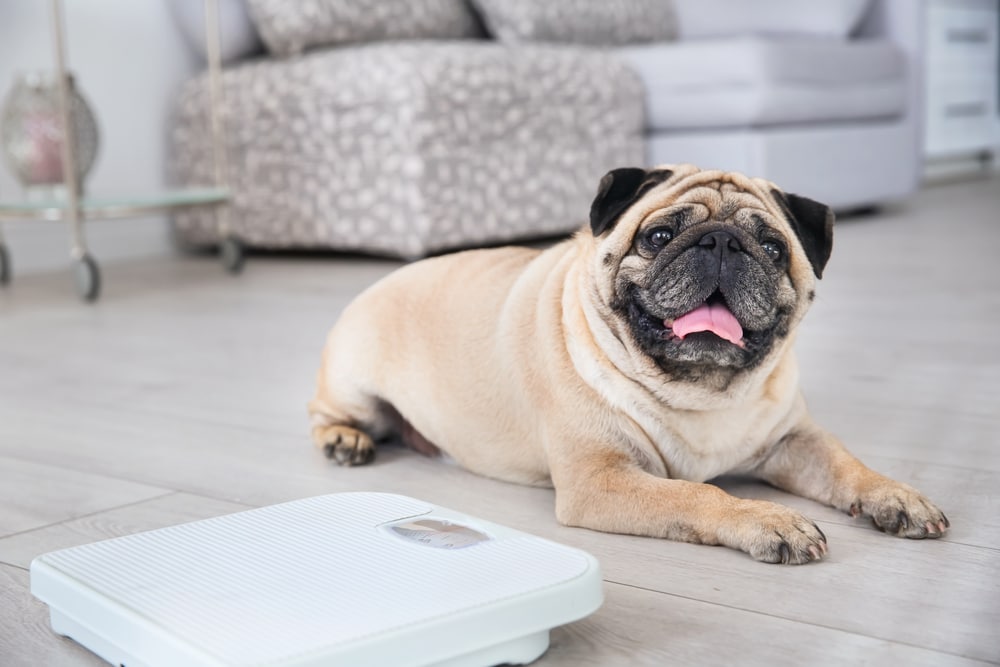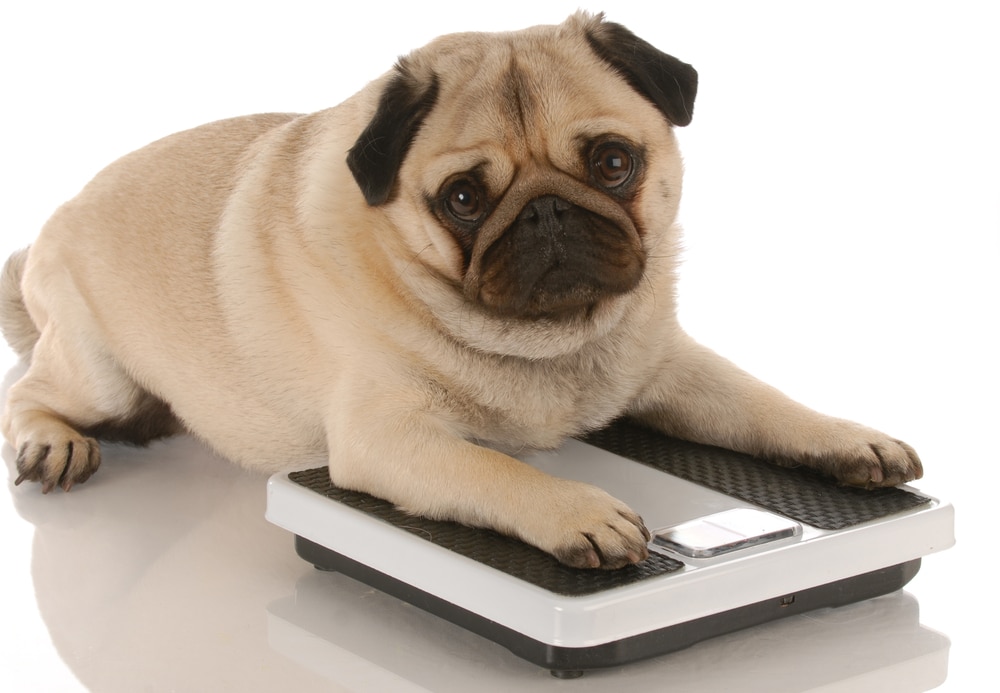With the internet’s recent obsession with chubby animals, it bombards us with posts featuring rotund cats and dogs. With all this imagery, it can be difficult for many owners to recognize the difference between a healthy weight and obesity in their own pets. As a responsible owner, one of the questions you should be asking yourself is, “How do I tell if my dog is obese?”
Regular weigh-ins and checkups with your veterinarian can help you monitor your dog’s weight and nip unhealthy weight gain in the bud. Monitoring your dog’s movement and evaluating their body condition score can also provide good insight into how their current weight is affecting them and what can be done to improve the situation.
Table of Contents
What Is Obesity?
Obesity is the accumulation of excess body fat in dogs due to an excessive energy intake that is disproportionate to the output. A dog that is 10-20% above the normal body weight is considered overweight, and one that is over 20% is considered obese. It is the most common nutritional disorder in dogs and can lead to various health complications.
How Does A Dog Become Obese?

Weight gain occurs when a dog’s calorie consumption far outweighs the number of calories it expends. This imbalance occurs due to improper volume, frequency, or nutritional composition of their diet that leads to an undue intake or a sedentary lifestyle that restricts calorie expense. In many cases, a combination of the two factors is involved in making our dogs obese.
Disruption of certain hormones can influence your dog’s weight gain as well. The most common example occurs after neutering. The surgery itself does not automatically promote excess fat deposition, but it may alter your dog’s satiety or their ability to feel full, causing them to eat more than usual. Certain diseases, such as hypothyroidism, hyperadrenocorticism, and insulinomas, can also affect the hormone systems that regulate satiety.
Some medications, such as phenobarbitone and glucocorticoid steroids, can also contribute to obesity because they reduce satiety and alter the fat deposition in their bodies respectively.
Is Obesity A Genetic Condition?
Breeds such as labradors, golden retrievers, Newfoundlands, terriers, pugs, beagles, and dachshunds are considered to be at a higher risk of becoming obese, despite owner efforts to maintain a healthy diet and exercise routine. For example, a 2016 study conducted by the University of Cambridge found a deletion in the proopiomelanocortin (POMC) gene of labradors that is thought to contribute to excessive body weight, fat accumulation, and food motivation.
However, obesity is not inevitable even in these breeds, and it should not be taken for granted that all labradors will be fat. Being a responsible caretaker of these breeds means maintaining stringent portion control and providing adequate exercise for your pet so they may live a long and happy life.
The Dangers Of Obesity
Despite the current trend glorifying roly-poly animals, obesity is significantly linked to a decreased lifespan and quality of life and puts your dog at increased risk of heart disease, joint problems, diabetes, urinary stones, and hypothyroidism, to name a few.
Dogs that are very fat are also prone to drug overdose due to their disproportionate body composition. Some hospitals refuse to perform surgery on morbidly obese pets because the risk of putting them under anesthesia becomes too great.
Signs Your Dog’s Weight Is Making Them Uncomfortable
Obese pets have a lower quality of life as compared to their healthier counterparts. Excessive body weight makes it harder for their bodies to function normally enough to do regular things. A dog that is too fat will often:
- Be less active
- Have difficulty standing up or sitting down
- Struggle or even refuse to climb stairs
- Become tired very easily
- Pant excessively
- Have difficulty breathing
- Make snorting sounds as they breathe
Body Condition Scoring
The best way to monitor your dog’s weight is to attend regular health checks at your veterinarian. They will be able to monitor your dog’s body weight and catch any sudden changes early enough to prevent complications.
In the meantime, Royal Canin has come up with a simple scoring system to monitor your dog’s weight. Body condition scoring can be done on a 5- or 9-point scale, and it allows an objective way to monitor your pet’s body weight. The scoring is done by visual assessment and palpation of your dog’s body.
The ideal dog should have a belly that gently curves inwards behind the rib cage, giving an hourglass shape when viewed from above. When looked at sideways, its tummy should be tucked and slant upwards between the ribcage and the hind legs.
Of course, in fluffy dogs, these visual changes may be less apparent. We can further evaluate by touching their ribs, backbone, and rump to check for fat cover. If your dog isn’t too fat, you should be able to easily feel the bones without applying too much pressure.
What Can You Do About Your Dog Being Obese?
If you’ve identified your dog is obese, a few lifestyle changes may be in order to bring it back to an ideal body weight. The first step is to weigh your dog. Having an accurate body weight will tell you exactly how much weight your dog needs to shed. Creating measurable milestones will help keep you motivated during your dog’s weight loss journey.
When it comes to nutrition, it is important to work together with your veterinarian to come up with a suitable plan aimed at weight loss. The solution is not immediately halving your dog’s meals; drastic changes can lead to unnecessary complications. Your veterinarian may recommend a specific product or formulate a meal plan that is then gradually introduced to your pet.
During the weight loss phase, it is critical that you stick to the plan. Resist the temptation to provide additional snacks and tidbits. Dog treats and table scraps are extremely high in calories and can have a disastrous effect on your dog’s weight loss. If your dog absolutely must have an occasional snack, use healthy alternatives like carrots and air-popped corn and incorporate these into the meal plan, so the calories are accounted for.
In Conclusion: How To Tell If My Dog Is Obese?
As their caretakers, it is our responsibility to make sure our dogs remain happy and healthy. A responsible owner must understand that maintaining health and welfare is a more sustainable measure of love than providing food in abundance just because your dog wants it. Recognizing obesity is the first step to addressing it and helping your dog live a good, long life.
So, how do you plan to keep your dog from being obese? If it already is, how do you plan to help? Let us know in the comments below!
